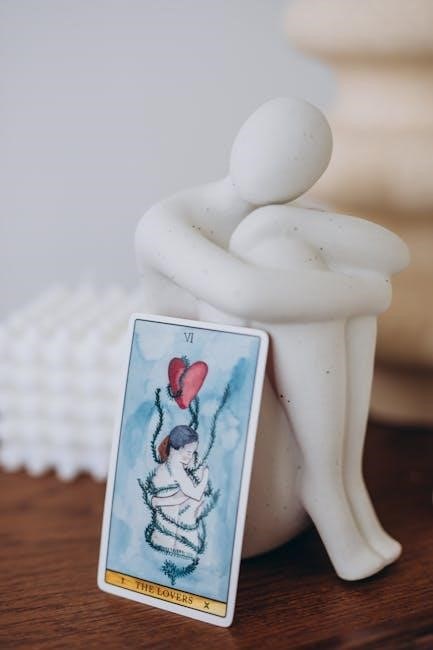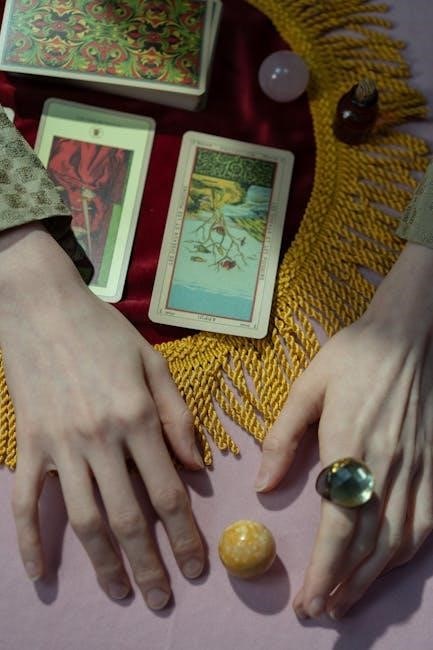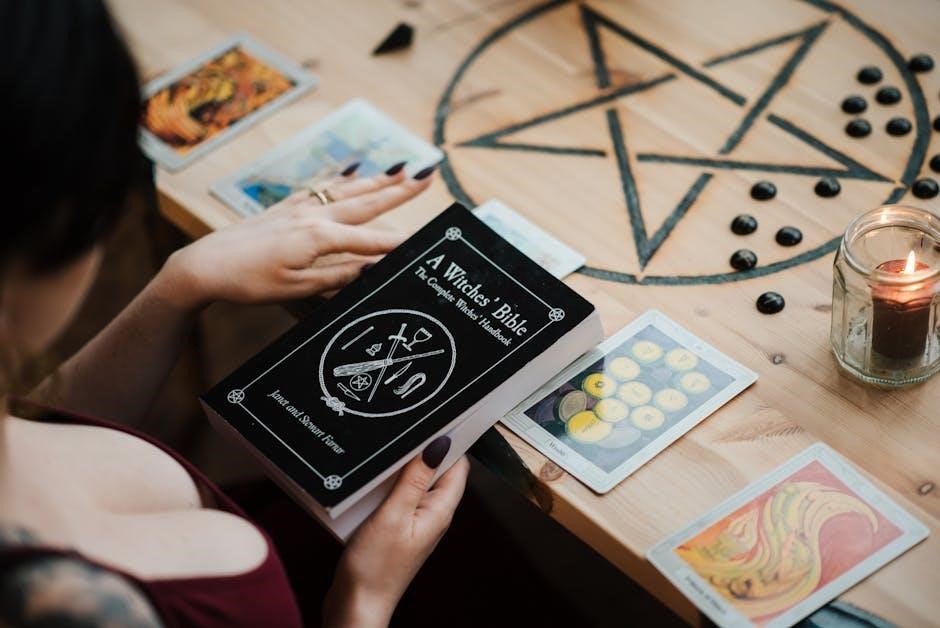tarot card interpretation pdf

Tarot card interpretation has evolved from a simple game into a profound spiritual tool, offering insights through its structured deck and symbolic imagery, now accessible via PDF guides.
What is Tarot Card Interpretation?
Tarot card interpretation is a practice that involves using a deck of 78 cards, each with unique symbolism and imagery, to gain insights into an individual’s life, challenges, and future. Rooted in centuries of tradition, tarot has evolved from a simple parlor game into a tool for self-reflection, spiritual guidance, and fortune-telling. A skilled practitioner or individual interprets the cards based on their positions in a spread and their interaction with one another. This practice is deeply personal, as the meaning of each card can vary depending on the context of the reading and the question being asked. With the rise of digital resources like tarot card interpretation PDF guides, beginners and experienced readers alike can access detailed explanations and interpretations to deepen their understanding of this ancient craft.
Brief History and Evolution of Tarot
Tarot card interpretation traces its origins to 15th-century Italy, where tarot cards were first used as a game called Tarocchi. Over centuries, tarot spread across Europe, evolving in meaning and design. By the late 18th century, it became associated with occultism and divination in France. The 20th century saw the rise of popular decks like the Rider-Waite-Smith, which standardized symbolism for modern interpretations. Tarot transitioned from entertainment to a tool for spiritual insight, with its imagery and archetypes offering deeper psychological and metaphysical meanings. Today, tarot is a global phenomenon, blending traditional practices with contemporary spirituality. The evolution of tarot reflects its adaptability, making it a enduring and versatile tool for self-discovery and guidance across cultures and eras.
The Role of Tarot in Modern Spirituality
Tarot has become a cornerstone of modern spirituality, serving as a tool for self-reflection, empowerment, and personal growth. It offers a way to connect with deeper truths about oneself and the world, transcending traditional religious frameworks. Many individuals use tarot to navigate life’s challenges, seek guidance, and explore their inner worlds. Its popularity has surged among younger generations and diverse communities, who appreciate its inclusive and adaptive nature. Tarot fosters introspection, encouraging users to embrace their unique journeys and harness their potential. As a spiritual practice, tarot bridges the gap between the mystical and the practical, providing a meaningful way to explore life’s complexities. Its accessibility through digital resources, like PDF guides, has further cemented its role in contemporary spiritual practices, making it a versatile and enduring tool for modern seekers.

The Structure of a Tarot Deck
A standard tarot deck contains 78 cards, comprising 22 Major Arcana cards representing significant life themes and 56 Minor Arcana cards, divided into four suits for everyday situations, often detailed in tarot card interpretation PDFs.
Major Arcana and Minor Arcana

The tarot deck is divided into two main sections: the Major Arcana and the Minor Arcana. The Major Arcana consists of 22 cards, each representing significant life themes, spiritual lessons, and major transitions. These cards, such as the Fool, the Lovers, and the Death card, hold deep symbolic meaning and often signify profound changes or insights in a reading. In contrast, the Minor Arcana includes 56 cards, divided into four suits (Wands, Cups, Swords, and Pentacles), which reflect everyday situations, emotions, and challenges. Each suit corresponds to a specific area of life, such as creativity, relationships, thoughts, and material possessions. Together, the Major and Minor Arcana provide a comprehensive framework for understanding the past, present, and future, making them essential components of tarot card interpretation PDF guides.
Symbolism and Imagery in Tarot Cards
Tarot cards are rich in symbolism and imagery, which are essential for interpretation. Each card features unique symbols, such as stars, water, fire, and animals, that carry specific meanings. These visuals often represent universal themes and archetypes, making them relatable and profound. For example, water symbolizes emotions, while fire represents passion or transformation. The imagery also incorporates elements like colors and numbers, which add layers of interpretation. Tarot card interpretation PDF guides often decode these symbols, helping readers understand their significance. The combination of these visual elements creates a language that connects the conscious and subconscious, allowing for deeper insights into the self and the universe. By studying the symbolism and imagery, tarot becomes a powerful tool for self-reflection and spiritual growth, offering guidance through its timeless and universal visuals.
The Importance of Card Positions in a Spread
In tarot readings, the position of each card in a spread holds significant meaning, shaping the interpretation of the entire reading. Each position is designed to address specific aspects of a question or situation, such as the past, present, future, challenges, or outcomes. For example, in a Celtic Cross spread, the center card represents the current situation, while the cross card signifies challenges. Understanding these positions is crucial for accurately interpreting the cards, as their placement influences their meaning. Tarot card interpretation PDF guides often detail the roles of each position in popular spreads, helping readers decode the narrative. By focusing on card positions, tarot becomes a structured tool for exploring complex questions, offering clarity and depth to the reading. This structured approach enhances the precision and relevance of the insights provided.

Interpreting Tarot Cards

Tarot interpreting combines symbolic imagery with intuition to offer insights. PDF guides simplify understanding card meanings and their connections, making tarot accessible for personal growth and self-reflection.
Understanding the Meaning of Each Card
Understanding the meaning of each tarot card is foundational to effective interpretation. The deck consists of 78 cards, each carrying unique symbolism and imagery. The Major Arcana cards, such as the Fool and the Death, represent major life themes and transitions, while the Minor Arcana cards reflect everyday situations and emotions. Tarot card interpretation PDF guides provide detailed explanations of each card’s symbolism, helping readers connect with their deeper meanings. These guides often include keywords, astrological associations, and imagery analysis to aid comprehension. By studying these resources, individuals can better interpret how each card relates to their personal journey or question. This knowledge enables users to tap into the tarot’s potential for self-discovery, decision-making, and spiritual growth, making it a powerful tool for both beginners and experienced practitioners.
The Interaction Between Cards in a Reading
The interaction between cards in a tarot reading is crucial for gaining deeper insights. Tarot card interpretation PDF guides emphasize that the relationship between cards in a spread influences the overall meaning. Each card’s position and its proximity to others create a narrative, revealing how different energies or situations are connected. For example, a card representing challenges may gain context when placed near a card symbolizing growth, indicating overcoming obstacles. These guides often provide tips on how to analyze card interactions, such as identifying complementary or conflicting themes. By understanding these dynamics, readers can uncover layered meanings and provide more comprehensive interpretations. Tarot card interpretation PDFs also highlight how card interactions can reveal underlying patterns or synergies, enhancing the accuracy and depth of a reading. This approach allows users to move beyond individual card meanings and embrace the tarot’s storytelling potential.
Reversals in Tarot and Their Significance
Reversals in tarot add depth and complexity to interpretations, offering alternative perspectives on card meanings; When a card appears upside down, it can indicate blocked energies, delayed outcomes, or the opposite of its upright meaning. Tarot card interpretation PDF guides often discuss how reversals can signify unconscious patterns, internal conflicts, or external obstacles. These resources provide insights into interpreting reversals, suggesting they may highlight areas where growth is stifled or where a different approach is needed. Some guides recommend considering the card’s position in the spread to understand the reversal’s impact. While not all readers use reversals, they can offer a nuanced understanding of challenges and opportunities. By exploring reversals, tarot card interpretation PDFs empower users to uncover hidden dynamics and gain a more comprehensive understanding of their readings.

Tarot and Astrology
Tarot and astrology are interconnected tools for self-discovery and spiritual growth. Tarot card interpretation PDFs explore their symbolic links, revealing how zodiac signs and planetary influences shape card meanings and readings.

Zodiac Signs and Tarot Connections
Zodiac signs and tarot cards share a deep symbolic connection, with each sign linked to specific tarot cards that reflect its energies and traits. For example, Aries is often associated with The Emperor, representing leadership and ambition, while Cancer aligns with The High Priestess, symbolizing intuition and emotional depth; These connections allow for a richer understanding of both tarot and astrology, blending celestial influences with card meanings. Tarot card interpretation PDFs often explore these relationships, offering insights into how zodiac signs can enhance tarot readings. By combining these tools, practitioners can gain a deeper understanding of personal energies and life paths, making tarot a powerful companion for astrological guidance and self-reflection.
Planetary Influences on Tarot Interpretations
Planetary influences significantly shape tarot interpretations, as each planet corresponds to specific energies and themes within the tarot deck. For example, Mercury’s influence is often linked to communication and logic, reflected in cards like The Magician, while Venus aligns with themes of love and harmony, seen in The Empress. Tarot card interpretation PDFs frequently explore these celestial connections, offering deeper insights into how planetary positions can enhance readings. By understanding these influences, practitioners can better interpret how cosmic forces interact with the cards, providing a more nuanced and personalized approach to tarot. This integration of astrology and tarot allows for a richer exploration of life’s challenges and opportunities, making tarot a powerful tool for aligning with universal energies and gaining spiritual clarity.

Tarot for Self-Reflection and Empowerment
Tarot serves as a powerful tool for self-reflection and empowerment, offering personal insights into lives and emotions through interpretation, as detailed in many tarot card interpretation PDFs.
Using Tarot as a Personal Growth Tool
Tarot cards are increasingly used as a personal growth tool, helping individuals gain self-awareness and emotional clarity. By reflecting on card meanings, users can identify patterns, challenges, and opportunities for improvement. Many tarot card interpretation PDFs offer structured exercises and spreads designed to facilitate introspection and goal-setting. These guides often include prompts for journaling or meditation, encouraging users to connect with their inner selves. Tarot’s symbolic language allows individuals to explore subconscious thoughts and emotions, fostering a deeper understanding of their motivations and desires. Regular tarot practice can empower individuals to make intentional decisions, cultivate mindfulness, and navigate life’s challenges with confidence. This holistic approach makes tarot a valuable resource for anyone seeking personal development and emotional well-being, as highlighted in various tarot card interpretation PDFs available online.

Tarot in Decision-Making and Self-Awareness
Tarot cards are a powerful tool for enhancing decision-making and fostering self-awareness. By interpreting the symbolism and themes in a tarot spread, individuals can gain clarity on complex choices and uncover subconscious influences. Tarot helps identify underlying patterns, strengths, and weaknesses, allowing for more informed and intentional decisions. Many tarot card interpretation PDFs provide frameworks for applying tarot to real-life scenarios, offering guidance on how to weigh options and align choices with personal values. This practice encourages self-reflection, helping users understand their motivations and goals. Tarot also fosters accountability by highlighting potential outcomes of different decisions. Whether seeking career guidance, relationship insights, or personal growth, tarot serves as a mirror for self-awareness, empowering individuals to navigate life’s challenges with greater confidence and purpose, as detailed in various tarot card interpretation PDFs.

Digital Tarot Resources
Digital tarot resources, like PDF guides and apps, offer modern tools for learning and practicing tarot. These resources provide instant access to interpretations, enhancing traditional practices with technology, making tarot more accessible.
The Rise of Tarot Apps and PDF Guides
The rise of tarot apps and PDF guides has revolutionized how people engage with tarot, offering convenience and accessibility. These digital tools provide detailed interpretations, guided spreads, and interactive features, making tarot more approachable for beginners and seasoned practitioners alike. PDF guides, in particular, serve as comprehensive resources for understanding card meanings, symbolism, and spreads. Apps often include virtual decks, allowing users to shuffle and draw cards digitally, with instant interpretations. This shift reflects the growing demand for holistic and spiritual tools in the digital age. Tarot apps and PDF guides not only preserve traditional practices but also innovate them, ensuring tarot remains relevant and accessible to modern audiences seeking self-reflection and empowerment.
How Technology is Changing Tarot Practices
Technology has significantly transformed tarot practices, making them more accessible and interactive. Tarot apps and digital platforms now offer virtual card decks, guided spreads, and instant interpretations, allowing users to explore tarot anytime, anywhere. PDF guides provide detailed explanations of card meanings, symbolism, and spreads, serving as valuable resources for both beginners and experienced practitioners. Additionally, technology enables personalized tarot experiences, such as custom spreads and progress tracking, enhancing self-reflection and empowerment. The rise of online communities and forums dedicated to tarot further fosters connection and knowledge-sharing among enthusiasts. Overall, technology is bridging tradition with modernity, ensuring tarot remains a vibrant and evolving spiritual practice in the digital age.




